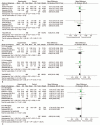Effects of spironolactone in heart failure with preserved ejection fraction: A meta-analysis of randomized controlled trials
- PMID: 30170387
- PMCID: PMC6392615
- DOI: 10.1097/MD.0000000000011942
Effects of spironolactone in heart failure with preserved ejection fraction: A meta-analysis of randomized controlled trials
Abstract
Background: Heart failure with preserved ejection fraction (HFpEF) is a common syndrome, accounting for more than one half of all heart failure patients, which is associated with high morbidity and mortality. But there is little evidence-based therapeutic strategies for the management of HFpEF. Previous studies reported the effects of spironolactone on HFpEF; however, the results were inconsistent. In this meta-analysis, we evaluated the effects of spironolactone on HFpEF.
Methods: Articles were searched on PubMed, EMBASE, and COCHRANE databases before May, 2017, and were supplemented by hand searches of reference lists of included studies and review articles. Eligible articles were restricted to randomized controlled trials (RCTs). The odds ratios (ORs) of the dichotomous data, mean difference (MD) of continuous data, and 95% confidence intervals (CIs) were calculated to assess the effects of spironolactone in patients with HFpEF.
Results: A total of 7 studies including 4147 participants were analyzed. There were significant improvements on the E/e' index (MD -1.38; 95% CI, -2.03 to -0.73; P < .0001) and E/A velocity ratio (MD -0.05; 95% CI, -0.10 to -0.00; P = .03) under spironolactone treatment compared with placebo, while there was no effect on the deceleration time (MD 1.04; 95% CI, -8.27 to 10.35; P = .83). Subgroup analyses on the E/A velocity ratio showed that there was obvious benefit from spironolactone therapy in patients with follow-up periods >6 months but not in those with follow-up periods ≤6 months. There was no reduction in all-cause mortality and hospitalization compared with placebo. And no improvement in 6-minute walk distance was seen compared with placebo.
Conclusion: This meta-analysis demonstrates that the use of spironolactone improves left ventricular diastolic function in patients with HFpEF, whereas it has no effect on all-cause mortality and hospitalization, and the 6-minute walk distance. Further larger size, multicenter, RCTs are required to confirm the effects of spironolactone on patients with HFpEF.
Conflict of interest statement
The authors have no conflicts of interest to disclose.
Figures



References
-
- Zakeri R, Mohammed SF. Epidemiology of right ventricular dysfunction in heart failure with preserved ejection fraction. Curr Heart Fail Rep 2015;12:295–301. - PubMed
-
- Tadic M, Pieske-Kraigher E, Cuspidi C, et al. Left ventricular strain and twisting in heart failure with preserved ejection fraction: an updated review. Heart Fail Rev 2017;22:371–9. - PubMed
-
- Garg N, Senthilkumar A, Nusair MB, et al. Heart failure with a normal left ventricular ejection fraction: epidemiology, pathophysiology, diagnosis and management. Am J Med Sci 2013;346:129–36. - PubMed
-
- Kapłon-Cieślicka A, Tymińska A, Peller M, et al. Diagnosis, clinical course, and 1-year outcome in patients hospitalized for heart failure with preserved ejection fraction (from the Polish Cohort of the European Society of Cardiology Heart Failure Long-Term Registry). Am J Cardiol 2016;118:535–42. - PubMed
Publication types
MeSH terms
Substances
LinkOut - more resources
Full Text Sources
Other Literature Sources
Medical

